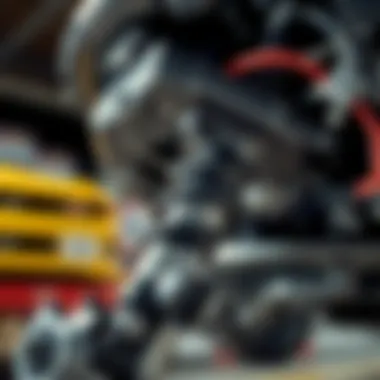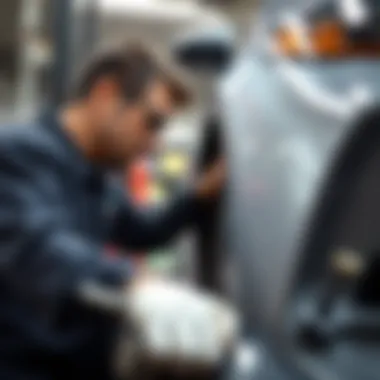Toyota Camry Struts Replacement Cost Explained


Intro
Understanding the ins and outs of struts replacement for a Toyota Camry is crucial for ensuring the longevity and performance of this popular sedan. Struts play a pivotal role in your vehicle’s suspension system, contributing not just to ride comfort but also to overall safety. Knowing the replacement costs, potential wear indicators, and necessary maintenance steps can help you avoid unforeseen expenditures down the road.
In this article, we aim to break down the various components that influence the cost of replacing struts in a Toyota Camry. We will explore factors such as the quality of parts, the labor involved, symptoms indicating strut failure, and the benefits of timely replacements. Through this comprehensive examination, we want to equip Toyota Camry owners and automotive enthusiasts with the knowledge required for informed decision-making regarding maintenance and repairs.
Overview of Toyota Camry Struts
Understanding the struts on a Toyota Camry is not just for the mechanics among us; it’s crucial for anyone who drives or owns one. Struts play a pivotal role in your vehicle's suspension system, influencing both ride quality and handling. When the struts function well, they absorb shocks from the road, allowing for a smoother journey. However, they can also wear out over time, affecting everything from safety to the car’s performance.
This section imparts foundational knowledge, shedding light on the components within the strut system and their specific roles. By grasping how these parts function together, you'll be more equipped to recognize when a strut replacement is needed and understand the potential costs involved.
Definition and Functionality
Struts are essentially structural components that support the weight of the vehicle while also providing a damping mechanism. Think of them like the backbone of your car's suspension system. They absorb bumps and vibrations, helping keep your tires in contact with the road, which enhances stability and control.
Over time, struts can lose their effectiveness—similar to how a sponge loses its absorbency. When this happens, you may notice issues, such as a bumpy ride or difficulty while steering. Ultimately, well-functioning struts are vital for maintaining your Camry's safety and driving comfort.
Types of Struts Used in Toyota Camry
When discussing struts in a Toyota Camry, it’s essential to differentiate between the types used across various models and years. Generally, there are two primary types: MacPherson struts and double-wishbone struts.
- MacPherson Struts: Most commonly found in the front suspension of the Camry, they are compact and integrate the shock absorber and coil spring into a single unit. This design is cost-effective and space-efficient.
- Double-Wishbone Struts: Often found in the rear suspension of some models, double-wishbone setups tend to provide better handling over uneven surfaces and better support during cornering.
Understanding these differences can assist car owners in making informed decisions about parts replacement and can lead to better overall vehicle performance, ensuring that your Toyota Camry continues to deliver a safe and enjoyable driving experience.
Understanding Struts Replacement
Understanding the significance of struts replacement goes beyond simply maintaining the smoothness of your drive; it influences your vehicle's overall performance and safety. The struts in your Toyota Camry play a critical role in how the vehicle handles different road conditions. They act as a cushion for your ride, absorbing shocks from potholes and rough surfaces. Neglecting them can lead to a cascade of issues that not only affect drivability but can also escalate repair costs in the long run.
Struts replacement addresses not just the suspension mechanics but also contributes to a safer driving experience. When your struts are failing, you may not notice the degradation immediately. However, over time, the symptoms of failure become evident and can escalate. By grasping the importance of regular inspections and timely replacements, you can prolong the lifespan of your vehicle and enhance ride quality. Let’s explore how to identify the signs of strut issues and the implications of ignoring these crucial components.
Indicators of Strut Failure
Unusual Noises
Unusual noises, such as clunks or knocks, can be a telltale sign that your struts are not performing as they should. These sounds often emerge during turns or bumps, suggesting that the struts are no longer effectively dampening the vehicle's movement. Recognizing such noises can save you a heap of trouble later. This aspect is crucial because it acts as an early warning system.


One of the key characteristics of unusual noises is their unpredictability; they can vary based on road conditions and your driving style. However, ignoring these sounds could lead to further suspension issues or even create a safety hazard. It's like trying to ignore a smoke alarm; the longer you wait, the more damage can occur.
Uneven Tire Wear
Uneven tire wear is another indicator of strut failure. Struts that are worn out can lead to tires losing contact with the road unevenly, which impacts traction and overall control. When you notice patches of wear on either edge of your tires, it could be a warning flag indicating strut problems.
This symptom stands out because it impacts not only the performance of your vehicle but can also break the bank through premature tire replacements. It's a clear illustration of how interconnected vehicle systems are. The unique feature of uneven tire wear is that it can also affect your fuel efficiency, further contributing to long-term costs associated with neglecting struts.
Poor Handling
Poor handling, characterized by excessive body roll or a front-heavy feel when turning, can greatly impact your driving experience. If you find yourself fighting with the steering wheel just to keep your Camry on the straight and narrow, your struts might be failing. It’s a glaring sign that something in your vehicle’s suspension system is amiss.
This characteristic of poor handling can often seem benign initially; however, it signifies a lack of control and stability. If left unchecked, it could compromise your ability to react in emergencies. Furthermore, poor handling can contribute to stress and wear on other suspension components, making it a costly issue to ignore. If your ride feels less like a purring engine and more like a bucking bronco, it’s high time to consider strut replacement.
Consequences of Neglecting Strut Replacement
Neglecting to replace worn-out struts can manifest in various ways, each carrying its own set of consequences. From safety issues like decreased braking efficiency to premature wear on shocks and tires, the cascade of problems can snowball quickly. The longer you wait, the more severe the repercussions become. Not only does this affect your wallet, but it may also compromise your safety and the safety of others on the road.
- Braking Distance Increases: Worn struts can lead to longer stopping distances, making emergency stops less effective.
- Loss of Vehicle Control: Reduced handling capabilities can make it challenging to navigate turns, especially at high speeds.
- Increased Wear on Related Components: Other parts such as shocks and tires may deteriorate faster when struts are not functioning correctly, which can further inflate repair costs.
"Ignoring strut issues is akin to ignoring a check engine light; it’s not just a nuisance, it’s a signal for immediate attention."
Cost Factors in Strut Replacement
When it comes to replacing struts in a Toyota Camry, understanding the various cost factors is vital. Struts play a crucial role in how the vehicle handles, rides, and ultimately, how safe it is on the road. Knowing what contributes to the overall replacement cost can help you budget effectively and make informed decisions for your vehicle maintenance.
Parts Pricing Analysis
OEM vs Aftermarket Parts
One of the first things to consider in the strut replacement process is whether to go with OEM (Original Equipment Manufacturer) parts or aftermarket options. OEM parts are made by the vehicle manufacturer, ensuring a perfect fit and optimal performance. This reliability is a significant reason many vehicle owners opt for OEM. On the other hand, aftermarket parts tend to be more affordable and can vary widely in quality. Some might be quite good, while others could be inferior.
The main characteristic to note here is the balance between cost and quality. While OEM parts do come at a premium, they are often recommended for their longevity and direct compatibility with your Toyota Camry. This value can translate into fewer repairs down the line, ultimately saving you money in the long run. Conversely, choosing aftermarket parts might reduce your upfront expenses but could lead to additional costs if you have to replace them sooner than you’d like due to quality issues.
Variability by Model Year
The model year of your Toyota Camry plays a significant role in the pricing and availability of struts. Different years may have distinct specifications or designs, leading to variances in part prices. For instance, struts from older models might be less expensive due to less demand, whereas newer models often demand higher prices due to advanced technology or materials.
It’s essential to recognize that this variability can impact not only the part costs but also the overall time and money spent in repairs. Parts for newer models may be more specialized, requiring more expertise and potentially prompting higher labor costs. Meanwhile, struts compatible with older models might be readily available and more cost-effective, making it easier to find affordable options even at local retailers or online stores.


Labor Costs Breakdown
Average Hourly Rates
Labor costs can be a significant portion of the strut replacement expense. Mechanics often charge hourly rates that can fluctuate by location, the shop's reputation, and the technician's level of expertise. Typically, you might see hourly rates ranging anywhere from $75 to $150 or more, depending on these factors.
This cost can add up quickly, and it’s crucial to understand what makes a shop worth the investment. A highly skilled mechanic might charge more, but their expertise can prevent costly mistakes, ensuring everything is done correctly the first time. On the flip side, choosing a cheaper service might save money but could lead to subpar work, resulting in additional expenses down the road.
Estimated Labor Time for Replacement
Estimating the labor time required to replace struts gives an idea of the overall cost. Generally, replacing struts on a Toyota Camry can take between 2 to 4 hours. The actual time can vary based on several factors, including the mechanic's experience and whether there are any unforeseen issues during the replacement process.
Understanding this timeline is essential, as it directly correlates with labor costs. If your shop charges $100 an hour, this means you could be looking at a labor bill of $200 to $400 just for the time spent replacing struts. Knowing this can help you manage your expectations and budget more effectively, allowing you to make informed decisions when tackling vehicle maintenance.
"Investing in quality parts and skilled labor during strut replacement can save vehicle owners money in the long run by preventing future issues."
In summary, digging into the specifics of both parts prices and labor costs can provide a well-rounded picture of what it takes to replace struts in a Toyota Camry. From understanding the benefits of OEM vs aftermarket parts to recognizing how your model year can make a difference, each aspect plays a role in planning your budget effectively.
What to Expect During Replacement
When it comes to replacing struts on a Toyota Camry, knowing what to expect can smoothen the whole process. This section aims to demystify the replacement journey, ensuring that owners are informed and prepared. Strut replacement is not just a routine task; it holds significant sway over how a vehicle handles and rides. Therefore, understanding the ins and outs can lead to better decisions regarding the vehicle's maintenance.
Preparation for Replacement
Preparation is key in any automotive repair, and that statement holds water when it comes to struts replacement. Before diving into the work, a few essential steps must be taken:
- Gather the Right Tools: Having the correct tools on hand can make the job easier. Common tools needed include:
- Purchase Quality Parts: Look into both OEM and aftermarket struts, weighing the benefits of each. Quality should never be compromised when it comes to parts.
- Establish a Safe Work Environment: Ensure that the working area is clean and well-lit. Outdoor work in a dry area can help avoid rust and debris getting in the crevices.
- Review Vehicle Manual: This will often have specifications relevant to strut replacement, such as torque specifications and detailed instructions unique to the model year.
- Socket set
- Torque wrenches
- Jack stands and floor jack
- Spring compressors
Preparation not only saves time but also reduces risks when you're deep in the nitty-gritty of the task.
Step-by-Step Replacement Process
Getting into the replacement process can be intricate, but breaking it down into manageable steps makes it straightforward. Here’s what the standard procedure generally looks like:
- Lift the Vehicle: Start by using a jack to lift the vehicle safely off the ground and secure it with jack stands. This is not optional but a fundamental safety measure.
- Remove the Wheel: Next, take off the wheel to gain access to the struts. It’s usually the simplest part, yet the most necessary.
- Detach the Strut from the Vehicle: Unbolt the top mounts and lower bolts holding the strut in place. This can sometimes be a chore due to rust or grime, so a little elbow grease might be necessary.
- Use Spring Compressors: To safely detach the coil spring from the strut, utilize spring compressors. This step is critical; improperly handled springs can cause severe injuries.
- Install the New Strut: Fit the new strut in reverse order of removal. It often helps to tighten the bolts only temporarily until everything is aligned properly.
- Reattach the Wheel and Lower the Vehicle: Once everything is secure, reattach the wheel and carefully lower the vehicle back to the ground.
- Final Adjustments: After lowering the vehicle, tighten bolts to the specified torque found in the vehicle’s manual. A double-check on everything can save future headaches.


"The struts on your Camry are not just pieces of metal. They are vital for both comfort and safety, influencing how you experience each drive."
Following these steps will give a clearer path through the replacement process, making it manageable for even the less experienced enthusiasts. This clarity not only boosts confidence but also lays a strong foundation for ongoing vehicle maintenance.
Long-term Considerations After Strut Replacement
Replacing the struts in your Toyota Camry isn’t just a one-off chore; it's a significant investment that affects the vehicle's performance for years to come. Struts serve as crucial components of your car’s suspension system. They contribute not only to a comfortable ride but also to the overall safety of your vehicle by keeping it stable. After replacement, there are a few key considerations to keep in mind to ensure your struts serve you well for the long haul.
Routine Maintenance Tips
Once you've had your struts replaced, adopting a routine maintenance plan becomes imperative. Taking proactive steps can prolong the life of your struts and keep your Camry running smoothly. Here are some tips to consider:
- Regular Inspections: Make it a habit to inspect your struts for leaks or damage every few months. Look for signs of wear and tear, especially after driving on rough terrain.
- Tire Alignment: After replacement, have your tires aligned. Misalignment can not only lead to uneven tire wear, but it can also put unnecessary stress on your new struts.
- Balance and Rotate Tires: Regularly balancing and rotating your tires will ensure even tread wear, reducing strain on the struts.
- Check Suspension Components: Keep an eye on other suspension parts. Worn parts such as bushings or sway bars can affect strut performance and may need replacing as well.
- Gentle Driving: Avoid potholes and rough roads when possible, as they can wear out any new suspension component quicker than expected.
Taking these steps may seem simple, but they make a world of difference. Think of it as the old saying goes: "A stitch in time saves nine." Keeping an eye on wear is much easier than replacing struts repeatedly.
Signs That Further Attention is Needed
Just because you've replaced your struts doesn't mean everything will go smoothly without further intervention. Here are some signs that indicate it might be time for additional attention:
- Persistent Noises: If you start hearing clunking or rattling noises, especially when going over bumps, it’s a red flag. While some noise is normal, anything out of the ordinary merits further investigation.
- Increased Vibration: Feeling more vibrations in the cabin compared to before can indicate strut issues or possibly other suspension problems.
- Diminished Ride Quality: If you notice your ride becoming bumpy or less stable even after replacing the struts, inspect them more closely or consult a mechanic.
- Unusual Tire Wear: Repeated patterns of uneven tire wear can point to alignment issues or further strut concerns. Check your tires regularly to catch these issues early.
"Ignoring these signs now can lead to larger expenses down the road, just like ignoring a simple tire rotation can balloon into premature strut failure."
Being vigilant allows for corrective actions before simple issues escalate into costly repairs. Keeping the health of your suspension in check isn’t just about the comfort of driving—it’s directly tied to safety. All in all, understanding and addressing these long-term considerations after strut replacement will undoubtedly enhance your experience and road safety in your Toyota Camry.
Ending and Recommendations
In wrapping up the discussion about struts replacement specifically for the Toyota Camry, it's vital to consider the overarching theme of this article – the importance of understanding the costs and implications associated with strut replacements. Struts are integral to the vehicle's suspension system, affecting everything from ride quality to handling and safety. Therefore, knowing when and how to approach strut replacement is not just a minor consideration, but a key aspect of responsible vehicle maintenance.
Weighing Costs Against Benefits
When contemplating strut replacement, it’s essential to weigh the costs against the benefits in a methodical manner. Strut replacement often demands a substantial financial investment. However, it’s important to note that neglecting strut issues can lead to much higher costs down the line. Consider these aspects:
- Safety: Properly functioning struts ensure your vehicle remains stable and predictable during maneuvers - this can be a life-saver during emergency situations.
- Performance: New struts improve steering response and ride quality, making your driving experience more enjoyable.
- Cost of Inaction: Delaying replacement could result in further damage to the suspension system or even early tire wear, leading to even steeper repair costs later.
Ultimately, if you notice any symptoms of strut failure, acting swiftly pays dividends. Replacing worn struts not only enhances your vehicle’s performance but also provides peace of mind while on the road.
Looking for Quality Service Providers
Finding a dependable mechanic for your strut replacement can feel like hunting for a needle in a haystack. Yet, the effort is worthwhile, as the right professional can make all the difference. Here are some tips to navigate this crucial part of the process:
- Reputation: Look for testimonials or reviews on platforms like Reddit or on specific automotive forums. Word of mouth can’t be overstated.
- Experience with Toyotas: Choose a provider well-versed in working on Toyota vehicles. They will likely have a better understanding of common issues and specific techniques necessary for effective replacements.
- Warranty: Ask about warranties on both parts and labor. A warranty offers a safety net for your investment, indicating the service provider stands behind their work.
- Cost Estimates: Get multiple estimates and scrutinize them. You should have a clear idea of what you’re being charged for – that includes both parts and labor.
"A well-maintained Camry not only drives better but also retains its value longer, making prudent maintenance decisions essential for any owner."



